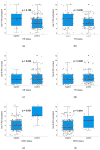High Galectin-7 and Low Galectin-8 Expression and the Combination of both are Negative Prognosticators for Breast Cancer Patients
- PMID: 32290551
- PMCID: PMC7226378
- DOI: 10.3390/cancers12040953
High Galectin-7 and Low Galectin-8 Expression and the Combination of both are Negative Prognosticators for Breast Cancer Patients
Abstract
Galectins are commonly overexpressed in cancer cells and their expression pattern is often associated with the aggressiveness and metastatic phenotype of the tumor. This study investigates the prognostic influence of the expression of galectin7 (Gal-7) and galectin8 (Gal-8) in tumor cell cytoplasm, nucleus and on surrounding immune cells. Primary breast cancer tissue of 235 patients was analyzed for the expression of Gal-7 and Gal-8 and correlated with clinical and pathological data and the outcome. To identify immune cell subpopulations, immunofluorescence double staining was performed. Significant correlations of Gal-7 expression in the cytoplasm with HER2-status, PR status, patient age and grading, and of Gal-8 expression in the cytoplasm with HER2-status and patient age and of both galectins between each other were found. A high Gal7 expression in the cytoplasm was a significant independent prognosticator for an impaired progression free survival (PFS) (p = 0.017) and distant disease-free survival (DDFS) (p = 0.030). Gal-7 was also expressed by tumor-infiltrating macrophages. High Gal-8 expression in the cytoplasm was associated with a significantly improved overall survival (OS) (p = 0.032). Clinical outcome in patients showing both high Gal-7 and with low Gal-8 expression was very poor. Further understanding of the role of galectins in the regulation and interaction of tumor cells and macrophages is essential for finding new therapeutic targets.
Keywords: Galectins; breast cancer; galectin-7; galectin-8; prognostic markers; tumor infiltrating macrophages.
Conflict of interest statement
Thomas Kolben holds stock of Roche AG and his relative is employed at Roche AG. Anna Hester has received a research grant from the “Walter Schulz” foundation and advisory board, speech honoraria and travel expenses from Roche and Pfizer. Research support, advisory board, honoraria, and travel expenses from AstraZeneca, Clovis, Medac, MSD, Novartis, PharmaMar, Roche, Sensor Kinesis, Tesaro, Teva have been received by Sven Mahner. All other authors declare no conflict of interest. The funders had no role in the design of the study; in the collection, analyses, or interpretation of data; in the writing of the manuscript, or in the decision to publish the results.
Figures








References
-
- Sorlie T., Tibshirani R., Parker J., Hastie T., Marron J.S., Nobel A., Deng S., Johnsen H., Pesich R., Geisler S., et al. Repeated observation of breast tumor subtypes in independent gene expression data sets. Proc. Natl. Acad. Sci. USA. 2003;100:8418–8423. doi: 10.1073/pnas.0932692100. - DOI - PMC - PubMed
LinkOut - more resources
Full Text Sources
Research Materials
Miscellaneous

